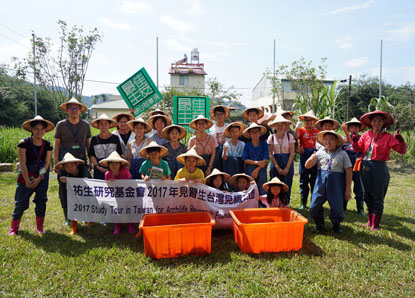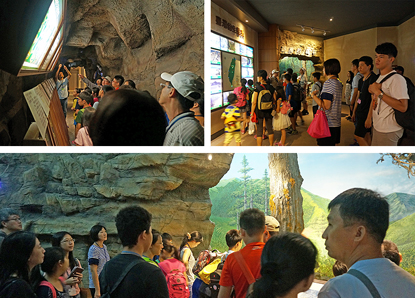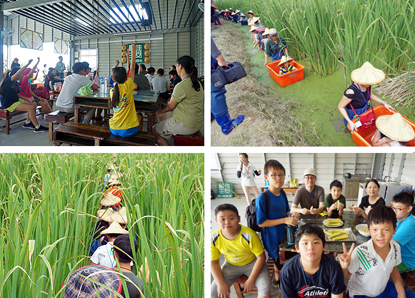Sketch of Archilife Study Tour, August 2017
|
2017年8月份見識之旅縮影  8月份見識之旅活動,於2017年8月26日由呂明澐小姐帶領25位祐生見習生及家長們,進行南投特有生物保育中心暨埔里農事體驗之旅。出發當日天氣晴朗,見習生們及其家長準時集合並出發。活動開始之初,領隊呂明澐小姐提醒本次活動注意事項及觀察重點,先行建立見習生的背景知識。 8月份見識之旅活動,於2017年8月26日由呂明澐小姐帶領25位祐生見習生及家長們,進行南投特有生物保育中心暨埔里農事體驗之旅。出發當日天氣晴朗,見習生們及其家長準時集合並出發。活動開始之初,領隊呂明澐小姐提醒本次活動注意事項及觀察重點,先行建立見習生的背景知識。For the study tour of August 26, 2017, Ms. Lu Ming-yun led 25 ARF interns and their parents on a tour to visit Nantou's Endemic Species Research Institute and experience farming in Puli. It was clear and sunny on the day of the tour, and the interns and their parents were on time for the departure. At the start of the day's activities, team leader Ms. Lu Ming-yun reminded everyone about things to note and what to observe, and provided the interns some general background knowledge.  本次上午行程參訪特有生物保育中心,其以推動鄉土生態教育為宗旨,來增進國人對野生生物保育觀念的重視。行程一開始,以早期的大樹公文化為開場,導覽人員說明人與自然亙古以來相互依存之理,卻為追求經濟發展,導致環境破壞,許多物種瀕臨滅絕,帶出環境保育的重要性。隨後,進入樹根洞穴,導覽人員配合圖示介紹根的種類,植物為了生存演變出不一樣的根來適應不同的生長環境,並解說一般的根如何汲水,以及移植大樹時應從根部的何處著手,才不會影響其後續吸取水分的功能。接著以台灣生態系為主軸,根據不同海拔高度講解不同的森林林相及動植物,反映出台灣雖位於亞熱帶,卻因地形變化,擁有相當豐富的生態資源。最後,至蜘蛛特展樓層進行導覽,館內展出多種蜘蛛標本與看板,介紹蜘蛛種類與生態,蜘蛛除了織網捕捉獵物與吸引求偶對象外,亦擅長偽裝、融入環境躲避天敵,有些生活於濕地的蜘蛛,可在水面上滑行並潛水避敵,顛覆眾人以往對蜘蛛的想像。 本次上午行程參訪特有生物保育中心,其以推動鄉土生態教育為宗旨,來增進國人對野生生物保育觀念的重視。行程一開始,以早期的大樹公文化為開場,導覽人員說明人與自然亙古以來相互依存之理,卻為追求經濟發展,導致環境破壞,許多物種瀕臨滅絕,帶出環境保育的重要性。隨後,進入樹根洞穴,導覽人員配合圖示介紹根的種類,植物為了生存演變出不一樣的根來適應不同的生長環境,並解說一般的根如何汲水,以及移植大樹時應從根部的何處著手,才不會影響其後續吸取水分的功能。接著以台灣生態系為主軸,根據不同海拔高度講解不同的森林林相及動植物,反映出台灣雖位於亞熱帶,卻因地形變化,擁有相當豐富的生態資源。最後,至蜘蛛特展樓層進行導覽,館內展出多種蜘蛛標本與看板,介紹蜘蛛種類與生態,蜘蛛除了織網捕捉獵物與吸引求偶對象外,亦擅長偽裝、融入環境躲避天敵,有些生活於濕地的蜘蛛,可在水面上滑行並潛水避敵,顛覆眾人以往對蜘蛛的想像。The morning's itinerary began with a visit to the Endemic Species Research Institute, which aims to promote local ecological education so as to draw greater attention to the concept of wildlife conservation. Introducing "the worship of Tree Deity" in the early days, the tour guide began by explaining the interdependent relationship between humanity and nature since time immemorial, and emphasized that environmental conservation is important as the pursuit of economic development has resulted in environmental destruction and near extinction of many species. Moving into a cave encased by tree roots, the tour guide introduced the different types of roots by illustrations, explaining that different roots are evolved to adapt to different environments. The tour guide also explained how water travels up from the root, and which part of the root to handle first when transplanting a tree in order not to affect the roots' ability to draw water. Next, the tour guide explained the different types of forest, and characteristics of flora and fauna, according to their altitudes, reflecting the rich diversity of Taiwan's ecological resources despite its subtropical location. Finally, in the spider exhibition area, interns learned about the different types of spider and their ecology from the extensive collection of specimens and display boards. Besides trapping preys and attracting mates with their webs, spiders are also good at disguising and blending in with the environment to hide from their predators. Some spiders living in the wetland can even glide over water surfaces and submerge themselves in water to avoid their predators, contrary to what everyone had imagined.  午餐前往埔里「最佳主茭腳白筍農場」,享用當地風味餐。飯後,由農場主人對於茭白筍相關知識進行解說,茭白筍並非筍子的一種,而是菰稻的莖寄生菰黑穗菌,使莖部膨大,而產生了茭白筍。緊接著,眾人穿著青蛙裝下水田進行農事體驗,首先,農場主人教導如何從外觀辨認茭白筍成熟與否,以及於水田中行走的訣竅。隨即針對漂浮在水面上的浮萍說明其特徵與功能,並介紹於茭白筍植株上築巢的鳥類與其他共生生物,讓見習生得以親自接觸,並對於田園生態有更深入的了解。至此,本日活動已近尾聲,大家一起合照留念後各自返家,並期待於下次見識之旅再相見。 午餐前往埔里「最佳主茭腳白筍農場」,享用當地風味餐。飯後,由農場主人對於茭白筍相關知識進行解說,茭白筍並非筍子的一種,而是菰稻的莖寄生菰黑穗菌,使莖部膨大,而產生了茭白筍。緊接著,眾人穿著青蛙裝下水田進行農事體驗,首先,農場主人教導如何從外觀辨認茭白筍成熟與否,以及於水田中行走的訣竅。隨即針對漂浮在水面上的浮萍說明其特徵與功能,並介紹於茭白筍植株上築巢的鳥類與其他共生生物,讓見習生得以親自接觸,並對於田園生態有更深入的了解。至此,本日活動已近尾聲,大家一起合照留念後各自返家,並期待於下次見識之旅再相見。Lunch was local specialties at a water bamboo farm in Puli. After lunch, the farm owner explained that water bamboo is not really bamboo but the stem of the rice grass(Zizania latifolia), which swells into what is known as water bamboo when infected by the fungus, Ustilago esculenta. Everyone then donned waders and learned how to identify ripe water bamboo and walk properly in the water field. The farm owner also introduced the characteristics of duckweed and its functions, and birds nesting on the water bamboo plants and other symbiotic organisms. The hands-on experience provided the interns deeper understanding of farm ecology. At this point, the day's itinerary came to an end. Everyone returned to home after taking a group photo and looked forward to the next study tour. |

